Nature Notes
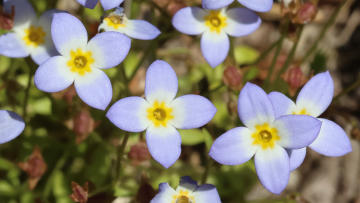
PHOTO COURTESY OF GARRY KESSLER
Little bluets are half an inch wide
May 19, 2024
NATURE NOTES
By Annie Reid
Westborough Community Land Trust
Our region’s little bluets
You know it’s May – or almost May – when you spot tiny sky-blue or snow-white wildflowers with yellow “eyes.” Known as little bluets or Quaker ladies, these native wildflowers grow in small clusters or large eye-catching patches of blue or white. When their exuberant May-June blossoming is over, you’ll still find bluets tucked into various places throughout summer and into fall.
Look for little bluets (Houstonia caerulea) along paths or in open woods, fields, cemeteries, roadsides, and even sparse lawns. Conspicuous in a mass, the flowers are only half an inch wide. They can be blue, white, or in-between, or occasionally pinkish. Each blossom is mounted on a thin stem 3-8 inches tall. The plant is a native perennial that spreads by seeds and by underground stems (rhizomes).
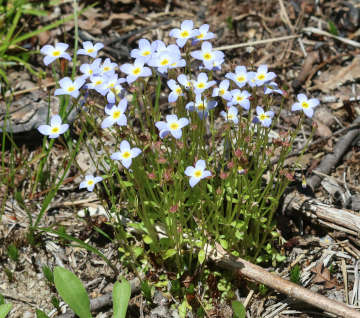
PHOTO COURTESY OF GARRY KESSLER
A clump of little bluets
The flowers have four petals at the top of a short tube that’s convenient for pollinating insects with a short “tongue” (proboscis). The flowers’ yellow centers are bulls-eyes leading bees, small butterflies, and tiny moths to the sweet nectar and pollen they seek.
The memorable name, Quaker ladies, may come from the bonnets once worn by Quaker women or from the color of the women’s dresses. Azure bluets is another name. Various other blue flowers share the name “bluet,” but the plant’s scientific name Houstonia caerulea is unique. It notes color with caerulea, which means “blue.”
Have you noticed how common blue is for spring flowers? Look around and you’ll see blue or blue-purple on violets of different kinds, blue flag iris, blue-eyed grass, wild geraniums, bittersweet nightshade, lilacs, and more. But why?
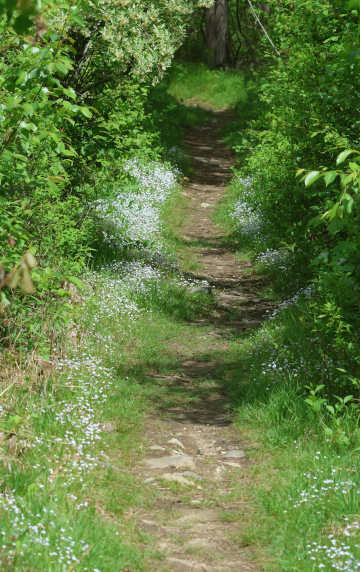
PHOTO COURTESY OF GARRY KESSLER
Little bluets along a path in May
Pollinating bees may be one big reason. You may have heard that “bees don’t see red.” It’s true. Bees are sensitive to a different set of wavelengths of light than we are. Specifically, bees see mixtures of green, blue, and ultraviolet (which we don’t see), and a bit of yellow-orange. Not surprisingly, the best flower colors to attract bees are purple, violet, and blue, although these wavelengths don’t look the same to bees as they look to us. (For fun, watch a short video comparing how flowers look to people, butterflies, and bees.)
What’s the point? Over the ages, many spring flowers have evolved blue colors that successfully attract bees. These colors are especially helpful in spring and fall (think asters). Early-season and late-season conditions can be tough for plants and pollinators. Nectar can be hard to find.
Have bluets served as food or medicine in the past, as many native plants have done? Some people today consider bluet flowers edible. Yet bluets are regarded as resistant to deer and rabbits. Perhaps those animals don’t like the taste.
Native Americans (Cherokee) reportedly made a leaf tea with bluets to cure bed-wetting. Such a use may have led to an odd, local Rhode Island nickname for bluets: pissabed (“piss-a-bed”).
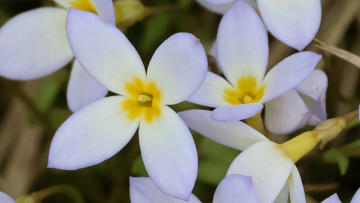
PHOTO COURTESY OF GARRY KESSLER
Two little bluet flower types: left, with tall pollen-receiving part in the center; right, with tall pollen-bearing part in the center.
As a part of local food chains or food webs (who-eats-whom), native plants are often hosts for insects (which become food for birds, other insects, and more). Our tiny bluets are host (food) for caterpillars of an equally tiny day-flying moth, the spotted thyris (Thyris maculata). It has a wingspan of half an inch.
Bluets are considered fire-resistant. This term means that they do not readily ignite from a flame, and that their foliage and stems do not significantly contribute to a fire’s intensity. Hundreds of years ago, bluets’ underground rhizomes may have helped them survive fires set by Native Americans to create open areas in woodlands.
What makes our native little bluets so successful? Their special way of promoting cross-pollination and genetic diversity plays a role. Every bluet flower has both male and female parts, but there are two types of flowers. Each type must be pollinated by pollen from the other type. This arrangement promotes cross-pollination between the two types of flowers and hinders self-pollination, leading to a healthier new generation of plants.
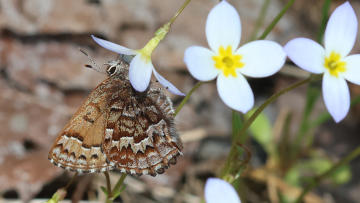
PHOTO COURTESY OF GARRY KESSLER
A pine elfin butterfly nectaring on a little bluet. Other small butterflies, including spring azures, gray hairstreaks, wild indigo duskywings, and pearl crescents, do likewise.
Here are some details, if you’re curious. In one type of flower, the male pollen-bearing parts (stamens with anthers) are tall, and the female pollen-receiving part (style with stigma) is short. In the other type of flower, these heights are reversed. The male pollen-bearing parts are short, and female pollen-receiving part is tall.
What happens when pollinating insects poke into the flowers? Pollen sticks to insects’ “tongues” in different places, depending on the height of a flower’s pollen-bearing parts. As pollinators move to other flowers, pollen from tall pollen-bearing parts is transferred mostly to flowers with tall pollen-receiving parts. Similarly, pollen from short pollen-bearing parts is transferred mostly to flowers with short pollen-receiving parts. The different flower types cross-pollinate.
New England has two somewhat larger relatives of little bluets. Long-leaved bluet (Houstonia longifolia) is less common. Large bluet (Houstonia purpurea) is rare.
Enjoy spring’s little bluets!